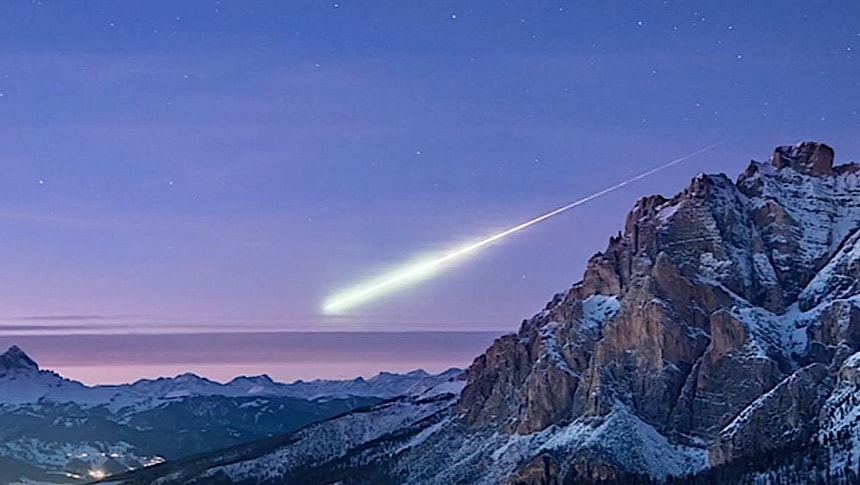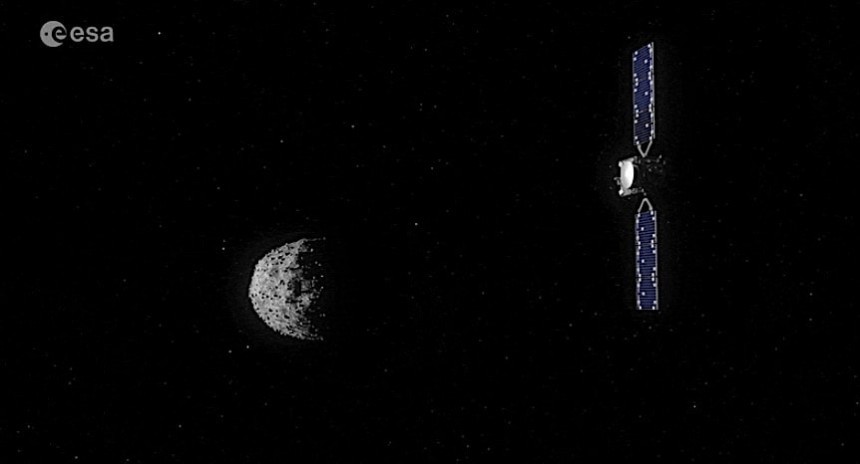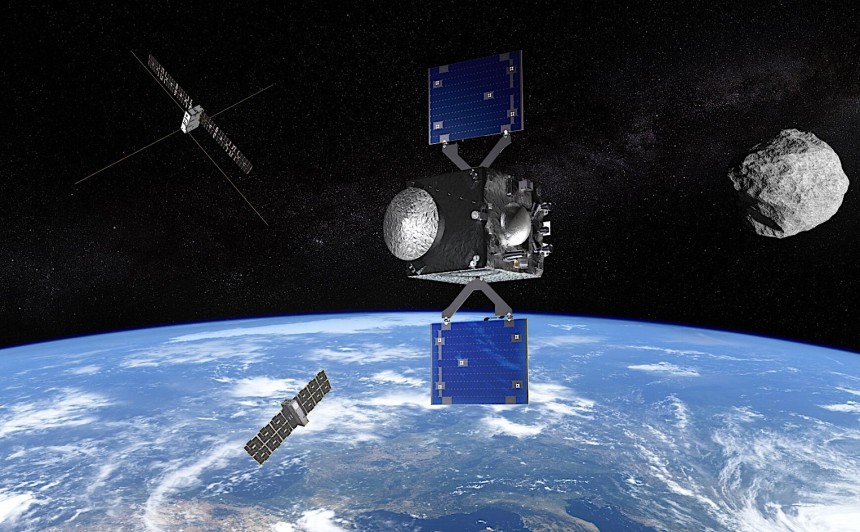Back in 2004 the world kept its breath for a little while as astronomers discovered a piece of space rock that was believed at the time had a pretty strong shot of hitting Earth. The rock is called asteroid 99942 Apophis, and even if we now know it will let us be, the thing still is immensely scary.
Apophis, also known as Apep, Apepi, or Aapep, was the god of darkness and chaos in the glory days of ancient Egypt. A fitting choice of name, then, for something that could cause incredible devastation on our planet if it were to hit us.
Apophis the asteroid is 1,100 feet (335 meters) across, which makes it about the size of a cruise ship. It was first believed it would have a pretty scary chance of impacting our world in 2029 or in 2068, but further research was conducted on the way it moves in our solar system and revealed that it will not endanger us in any way for the next century or so.
It will come a time, though, when this asteroid, or some other one, will head straight for us. It happened in the past, and it will definitely happen in the future, so the world's largest space agencies are hard at work trying to figure out ways of removing such a danger.
Back in 2021, American space agency NASA flew the "first-ever mission dedicated to investigating and demonstrating one method of asteroid deflection by changing an asteroid's motion in space through kinetic impact."
At the core of the mission was a spacecraft called Double Asteroid Redirection Test (DART), which struck the moonlet of the Didymos – Dimorphos asteroid pair at speeds of 14,000 miles (22.530 km) per second. It doing so, it altered the moonlet's orbit and speed around the main asteroid, and proved that knocking asteroids from their orbits could be done.
But one major hurdle in the way of us being able to do that is knowledge about the asteroid's shape and composition. And for us to gain that, we need to send spacecraft to investigate. And one such machine is already en-route to Apophis.
Last year NASA repurposed the asteroid sample retriever Origins, Spectral Interpretation, Resource Identification, and Security-Regolith Explorer (OSIRIS-REx), which delivered 4.3 ounces (121.6 grams) of alien world to Earth in 2023, and sent it out to meet with Apophis.
Renamed OSIRIS-APEX (meaning Apophis Explorer), the spacecraft will reach its destination in the exact year the asteroid makes its scary-close approach to our planet. Sadly, it will only arrive one month after the celestial body passes just 20,000 miles (32,000 km) from the surface. Its main mission is to map the surface and try to determine the composition of the rock.
But OSIRIS-APEX will not be the only spacecraft that will keep an eye on Apophis in 2029. The European Space Agency (ESA) is sending its own mission to do that, after it was initially approved last week.
The mission is named, somewhat fittingly, after an Egyptian pharaoh: Ramses. It's a rather forced moniker that actually stands for Rapid Apophis Mission for Space Safety, and marks Europe's first major planetary defense mission.
Unlike the OSIRIS-APEX, Ramses is scheduled to reach Apophis two months before its close approach, giving it a unique opportunity to study the way our planet affects the asteroid and its orbit from before it reaches its closest point to well after.
Ramses will pack a series of instruments that are yet to be detailed, but will build on the ones developed for the Hera mission that will survey the Didymos – Dimorphos pair post-impact. Using them, it will look at the rock's shape, surface, orbit, rotation, and orientation, and try to determine how all of that is impacted by the planet's immense gravity.
Scientists are quite hyped about the prospects of the Ramses mission, as this is an opportunity that almost never comes along - an asteroid of this size comes so close to Earth once every 5,000 to 10,000 years. And it so happens that this time we are advanced enough to learn something from it.
The Europeans believe that the research conducted on Apophis might shed new light on how external forces such as a planet's gravity impact composition, interior structure, cohesion, mass, density, and porosity. People hope to see even quakes and landslides on the surface of the asteroid. More importantly, we will have a view of an asteroid for the first time before and after it encounters a much larger celestial body.
This knowledge, in turn, might inform deflection missions that may just as well save our world sometime in the future. It might also shed new light on how the solar system formed and evolved.
ESA plans to fully approve the Ramses mission at the end of next year, if it is to meet the April 2028 launch window. Apophis will zip by Earth on April 13, 2029, and for two billion people in Europe, Africa, and Asia, it will be visible with the naked eye.
Apophis the asteroid is 1,100 feet (335 meters) across, which makes it about the size of a cruise ship. It was first believed it would have a pretty scary chance of impacting our world in 2029 or in 2068, but further research was conducted on the way it moves in our solar system and revealed that it will not endanger us in any way for the next century or so.
It will come a time, though, when this asteroid, or some other one, will head straight for us. It happened in the past, and it will definitely happen in the future, so the world's largest space agencies are hard at work trying to figure out ways of removing such a danger.
Back in 2021, American space agency NASA flew the "first-ever mission dedicated to investigating and demonstrating one method of asteroid deflection by changing an asteroid's motion in space through kinetic impact."
At the core of the mission was a spacecraft called Double Asteroid Redirection Test (DART), which struck the moonlet of the Didymos – Dimorphos asteroid pair at speeds of 14,000 miles (22.530 km) per second. It doing so, it altered the moonlet's orbit and speed around the main asteroid, and proved that knocking asteroids from their orbits could be done.
Last year NASA repurposed the asteroid sample retriever Origins, Spectral Interpretation, Resource Identification, and Security-Regolith Explorer (OSIRIS-REx), which delivered 4.3 ounces (121.6 grams) of alien world to Earth in 2023, and sent it out to meet with Apophis.
Renamed OSIRIS-APEX (meaning Apophis Explorer), the spacecraft will reach its destination in the exact year the asteroid makes its scary-close approach to our planet. Sadly, it will only arrive one month after the celestial body passes just 20,000 miles (32,000 km) from the surface. Its main mission is to map the surface and try to determine the composition of the rock.
But OSIRIS-APEX will not be the only spacecraft that will keep an eye on Apophis in 2029. The European Space Agency (ESA) is sending its own mission to do that, after it was initially approved last week.
The mission is named, somewhat fittingly, after an Egyptian pharaoh: Ramses. It's a rather forced moniker that actually stands for Rapid Apophis Mission for Space Safety, and marks Europe's first major planetary defense mission.
Unlike the OSIRIS-APEX, Ramses is scheduled to reach Apophis two months before its close approach, giving it a unique opportunity to study the way our planet affects the asteroid and its orbit from before it reaches its closest point to well after.
Scientists are quite hyped about the prospects of the Ramses mission, as this is an opportunity that almost never comes along - an asteroid of this size comes so close to Earth once every 5,000 to 10,000 years. And it so happens that this time we are advanced enough to learn something from it.
The Europeans believe that the research conducted on Apophis might shed new light on how external forces such as a planet's gravity impact composition, interior structure, cohesion, mass, density, and porosity. People hope to see even quakes and landslides on the surface of the asteroid. More importantly, we will have a view of an asteroid for the first time before and after it encounters a much larger celestial body.
This knowledge, in turn, might inform deflection missions that may just as well save our world sometime in the future. It might also shed new light on how the solar system formed and evolved.
ESA plans to fully approve the Ramses mission at the end of next year, if it is to meet the April 2028 launch window. Apophis will zip by Earth on April 13, 2029, and for two billion people in Europe, Africa, and Asia, it will be visible with the naked eye.









